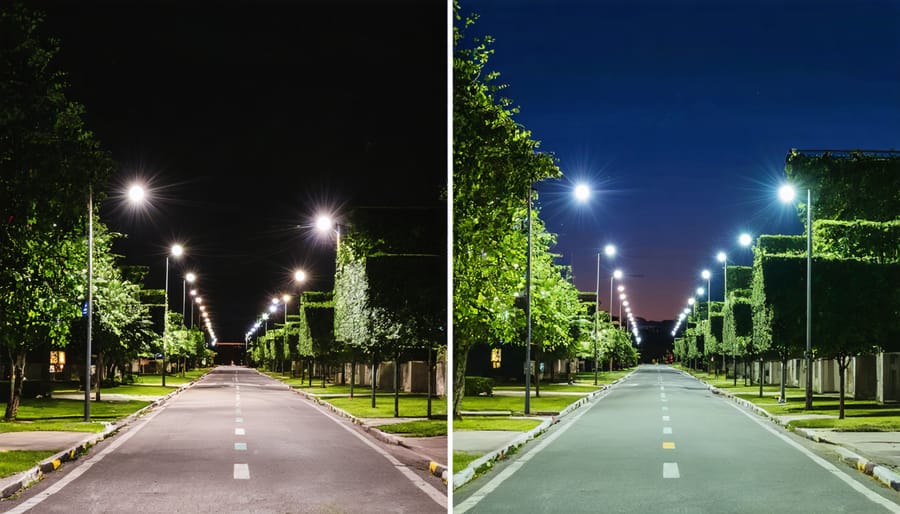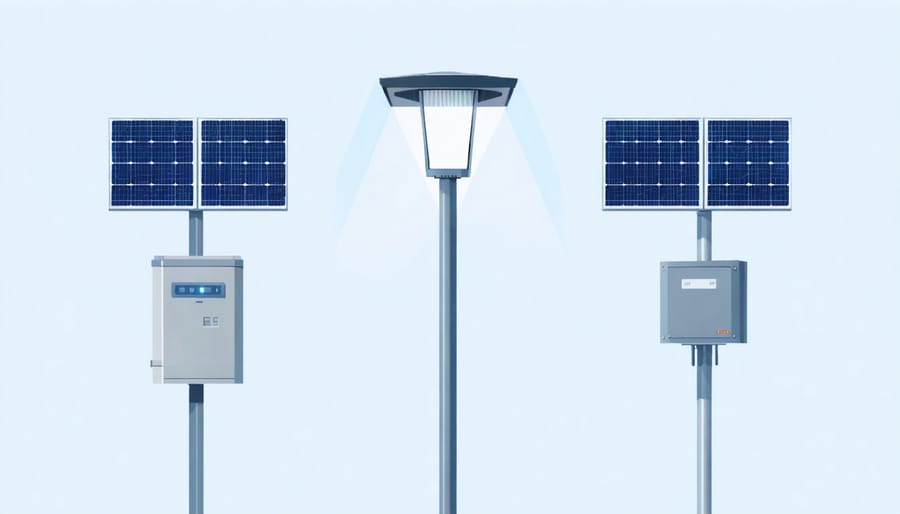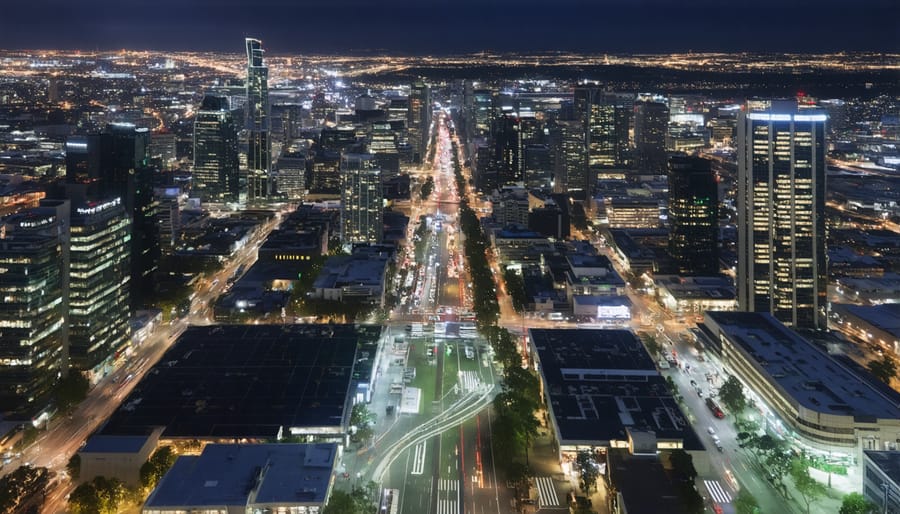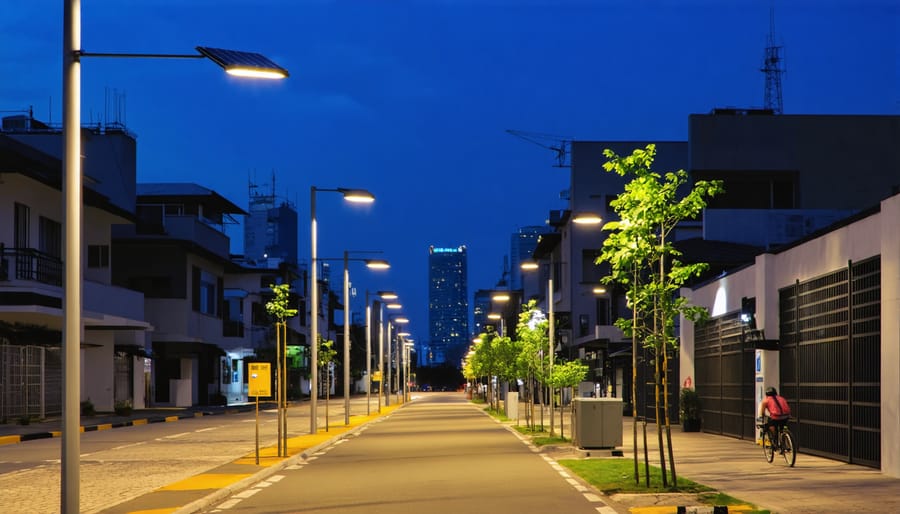As smart cities transform urban infrastructure, urban renewables are revolutionizing how Australian cities power themselves. From rooftop solar arrays spanning entire city blocks to wind turbines integrated into building designs, our metropolitan areas are becoming living laboratories for sustainable energy innovation.
Imagine Sydney’s skyline, where gleaming solar panels now capture enough energy to power thousands of homes, or Melbourne’s smart street lighting systems that automatically dim and brighten based on foot traffic. These aren’t future possibilities – they’re happening right now. Urban renewables represent more than just clean energy; they’re reshaping our cities into more resilient, efficient, and livable spaces.
The transformation is particularly visible in our public spaces, where smart lighting systems reduce energy consumption by up to 50% while improving safety and visibility. Local councils across Australia are leading this charge, proving that sustainable urban development isn’t just environmentally responsible – it’s economically sound.
This shift toward urban renewables isn’t just about technology; it’s about reimagining our cities as self-sustaining ecosystems where every surface has the potential to generate clean energy. From solar-powered bus stops to kinetic energy-harvesting footpaths, the possibilities are limitless. The future of urban energy is being written in our streets, and it’s powered by innovation that works in harmony with our natural environment.
Why Traditional Street Lighting Needs a Renewable Makeover

The Hidden Cost of Keeping Our Streets Lit
Traditional street lighting represents a significant portion of urban power consumption, with Australian councils spending millions each year keeping our streets illuminated. A typical suburban street light burns through approximately 1,000 kilowatt-hours annually, contributing substantially to local council energy bills. When you consider that a mid-sized city might maintain tens of thousands of street lights, the numbers quickly add up.
Beyond electricity costs, traditional lighting systems demand regular maintenance, including bulb replacement, wiring repairs, and infrastructure upgrades. Each maintenance call-out can cost councils hundreds of dollars, not counting the replacement parts. These systems also face reliability issues during extreme weather events, leading to additional emergency maintenance expenses.
The hidden expenses don’t stop there. Conventional street lights often waste energy through light pollution and inefficient distribution, effectively paying to illuminate the sky rather than our streets. This inefficiency impacts both council budgets and our environment, making the true cost of traditional street lighting significantly higher than what appears on the electricity bill.
Environmental Impact Beyond the Power Bill
Urban renewable projects deliver benefits far beyond reducing electricity bills. When cities embrace renewable energy solutions, they significantly decrease their carbon footprint and contribute to cleaner air quality. A typical solar-powered street lighting system can prevent up to 5 tonnes of CO2 emissions annually – equivalent to planting 80 trees.
The environmental advantages extend to reduced light pollution, particularly with modern LED fixtures that direct light precisely where needed. This thoughtful approach helps protect nocturnal wildlife and maintains natural ecosystems in urban areas. Smart lighting systems also minimize waste by automatically adjusting brightness based on natural light conditions and foot traffic.
By manufacturing renewable energy components locally and using sustainable materials, cities can further reduce their environmental impact. For instance, Brisbane’s solar light installations incorporate recycled materials in their poles and fixtures, creating a circular economy approach that minimizes waste.
Water conservation is another notable benefit, as renewable energy systems typically require less water for maintenance compared to traditional power generation methods. This is particularly crucial for drought-prone Australian cities working to build resilient, sustainable communities.
Solar-Powered Street Lights: The Game Changer
How Modern Solar Street Lights Actually Work
Modern solar street lights are marvels of sustainable engineering, combining several clever technologies to keep our streets illuminated without drawing from the power grid. At their heart, these systems feature high-efficiency solar panels that capture sunlight during the day, converting it into electrical energy. These panels are typically positioned at optimal angles to maximise sun exposure, even in urban environments where space might be limited.
The captured energy is stored in advanced lithium-ion batteries, similar to those in electric vehicles but scaled for lighting needs. These batteries are designed to hold enough charge to power the lights through multiple nights, even during periods of limited sunlight. Smart charge controllers protect the batteries from overcharging and ensure they operate at peak efficiency.
When darkness falls, photosensors automatically activate the LED lighting system. Modern LEDs are incredibly energy-efficient, using up to 80% less power than traditional street lights while providing superior illumination. Many systems now incorporate motion sensors and smart controllers that adjust brightness based on activity levels, further conserving energy when full illumination isn’t needed.
What makes these systems particularly brilliant for Australian cities is their ability to operate independently of the power grid. During our sunny days, they gather more than enough energy to power through our nights, and their weather-resistant design stands up to our harsh climate. Most systems can operate maintenance-free for up to five years, making them a practical and cost-effective solution for urban lighting.

Smart Features That Make Solar Lighting Practical
Modern solar lighting systems have evolved far beyond simple photovoltaic panels and LED bulbs. Today’s installations incorporate sophisticated smart energy management systems that maximise efficiency and reliability while minimising maintenance needs.
Motion sensors play a crucial role in these systems, automatically adjusting brightness based on pedestrian and vehicle activity. During quiet periods, lights dim to conserve energy, brightening instantly when movement is detected. This smart feature alone can reduce energy consumption by up to 40% compared to traditional systems.
Advanced weather monitoring capabilities enable lights to adapt to environmental conditions. On overcast days, the system automatically compensates by drawing more stored power, while clear days allow for maximum solar charging. Some systems even incorporate predictive analytics to optimise performance based on weather forecasts.
Remote monitoring and control capabilities allow facility managers to oversee entire networks from a central location. Real-time performance data helps identify maintenance needs before failures occur, while automated fault reporting ensures quick responses to any issues.
Perhaps most impressively, many modern systems now feature self-learning algorithms that continuously optimise performance based on usage patterns. These systems can adjust lighting schedules to match seasonal changes and local activity patterns, ensuring optimal illumination while maximising energy efficiency.
Real Performance in Australian Conditions
Australia’s diverse climate zones provide an ideal testing ground for urban renewable technologies, with performance data showing impressive results across different settings. From the sun-drenched streets of Darwin to the variable conditions of Melbourne, urban renewables have demonstrated remarkable adaptability and efficiency.
In Sydney’s central business district, solar-powered street lighting systems maintain 95% operational efficiency even during overcast periods, thanks to advanced battery storage solutions. Brisbane’s subtropical environment has proven particularly favorable, with renewable installations exceeding performance expectations by up to 20% during summer months.
Real-world monitoring in Perth shows that wind-solar hybrid systems in urban areas consistently deliver reliable power throughout the year, effectively managing seasonal variations. These systems have demonstrated resilience during extreme weather events, with backup systems ensuring uninterrupted operation during cyclones and severe storms.
Temperature fluctuations present minimal impact on performance, with modern systems engineered to operate efficiently in conditions ranging from -5°C to 45°C. Coastal installations in cities like Adelaide have shown excellent durability against salt spray and high humidity, with corrosion-resistant materials extending system lifespan beyond initial projections.
Data from regional centers like Townsville and Hobart demonstrates that urban renewables perform effectively across different population densities and urban layouts, adapting to varied architectural landscapes while maintaining optimal energy generation and storage capabilities.
Success Stories: Australian Cities Leading the Way
Melbourne’s Smart Lighting Revolution
Melbourne’s transformation into a smart city took a significant leap forward with its innovative renewable lighting project, which has become a blueprint for sustainable urban illumination across Australia. Launched in 2019, the initiative has already converted over 18,000 traditional streetlights to energy-efficient LED systems powered by renewable energy.
The project combines smart technology with sustainability, featuring motion sensors that adjust brightness based on foot traffic and weather conditions. During quiet hours, lights dim to 30% of their full capacity, brightening instantly when movement is detected. This adaptive system has reduced energy consumption by an impressive 56% compared to conventional lighting solutions.
Solar panels installed on council buildings and nearby facilities power these smart lights, while excess energy is stored in grid-connected batteries for use during nighttime hours. The system’s monitoring capabilities allow real-time tracking of energy usage and maintenance needs through a centralized digital platform.
The economic benefits have been substantial, with the city saving approximately $1.8 million annually in energy and maintenance costs. The environmental impact is equally impressive, with yearly carbon emissions reduced by 12,000 tonnes – equivalent to taking 2,500 cars off the road.
Local residents have reported feeling safer with the improved lighting quality, while astronomers appreciate the reduced light pollution. The success has inspired neighbouring councils to adopt similar systems, creating a ripple effect of sustainable urban lighting solutions across Victoria.
Melbourne’s smart lighting revolution demonstrates how renewable energy can enhance urban infrastructure while delivering tangible benefits to communities. The project’s success has positioned the city as a leader in sustainable urban development and provides a practical model for other Australian cities to follow.

Brisbane’s Solar Street Light Program
Brisbane’s transformation of its street lighting infrastructure stands as a shining example of urban renewable innovation in Australia. Since launching its Solar Street Light Program in 2019, the city has installed over 1,500 solar-powered street lights across various suburbs, resulting in an estimated annual reduction of 1,400 tonnes of carbon emissions.
The program’s success lies in its carefully planned implementation strategy. Brisbane City Council first identified high-traffic areas and community spaces that would benefit most from sustainable lighting solutions. The selected solar lights feature advanced LED technology, smart sensors, and battery storage systems that ensure reliable operation even during extended periods of cloudy weather.
What sets Brisbane’s initiative apart is its community-first approach. Local residents were actively involved in the planning process, helping identify areas where lighting improvements were most needed. The council also incorporated smart technology that adjusts light intensity based on pedestrian activity, maximizing energy efficiency while maintaining safety standards.
The financial benefits have been substantial. Despite the initial installation costs, the solar street lights have reduced the city’s energy bills by approximately 40% compared to traditional lighting systems. Maintenance costs have also decreased significantly, as solar-powered units require less frequent servicing and have longer operational lifespans.
The program has sparked interest from other Australian municipalities, with several councils now developing similar initiatives. Brisbane’s experience demonstrates that solar street lighting is not just environmentally responsible but also economically viable for urban areas. The success has encouraged the council to expand the program, with plans to install an additional 2,000 solar lights by 2025.
Making the Switch: Practical Steps for Communities
Transitioning to renewable lighting systems requires a well-planned community approach that combines strategic planning with practical implementation. The first step is conducting a comprehensive audit of existing lighting infrastructure and energy consumption patterns. This baseline assessment helps identify priority areas and potential quick wins.
Community engagement is crucial for success. Local councils should establish working groups that include residents, businesses, and technical experts to develop a shared vision and implementation strategy. These groups can help identify specific needs and concerns while building support for the initiative.
Funding is often a major consideration. Communities can explore various options, including government grants, public-private partnerships, and innovative financing models like Environmental Upgrade Agreements. Many Australian councils have successfully leveraged these mechanisms to fund their sustainable urban infrastructure projects.
Start with pilot projects in high-visibility areas to demonstrate benefits and build momentum. Public spaces like parks, main streets, or community centres make excellent starting points. Document energy savings, maintenance costs, and community feedback to build a strong case for broader implementation.
Consider a phased approach, replacing conventional lighting systems gradually during scheduled maintenance or upgrades. This helps manage costs while allowing for the incorporation of newer technologies as they become available. Partner with local contractors and suppliers to build capacity and ensure ongoing support for the systems.
The future of urban lighting is bright, quite literally, as renewable energy systems continue to transform our cityscapes. These innovative solutions are proving to be game-changers in our journey towards sustainable urban development. By combining solar panels, wind turbines, and smart technology, cities across Australia are demonstrating that renewable lighting systems not only reduce carbon emissions but also deliver substantial cost savings over time.
The benefits extend far beyond environmental considerations. Communities are experiencing enhanced safety through reliable, grid-independent lighting systems, while local governments are reporting significant reductions in maintenance and operational costs. The integration of smart controls and energy storage solutions ensures these systems remain effective even during challenging weather conditions.
Looking ahead, the outlook for urban renewable lighting is exceptionally promising. Technological advancements continue to improve efficiency and reduce installation costs, making these systems increasingly accessible to communities of all sizes. As more cities embrace these solutions, we’re likely to see further innovations in design and functionality, leading to even more efficient and adaptable systems.
For Australia’s urban future, renewable lighting systems represent a practical step towards creating more sustainable, resilient, and liveable cities. The momentum is building, and the path forward is clear: urban renewable lighting is not just a trend, but a fundamental component of our sustainable urban future.

